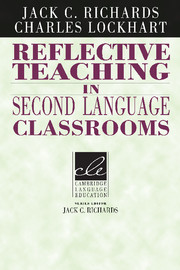Book contents
- Frontmatter
- Contents
- Series editor's preface
- Preface
- Introduction: Teacher development through exploring classroom processes
- 1 Approaches to classroom investigation in teaching
- 2 Exploring teachers' beliefs
- 3 Focus on the learner
- 4 Teacher decision making
- 5 The role of the teacher
- 6 The structure of a language lesson
- 7 Interaction in the second language classroom
- 8 The nature of language learning activities
- 9 Language use in the classroom
- Epilogue
- References
- Index
Series editor's preface
Published online by Cambridge University Press: 29 January 2010
- Frontmatter
- Contents
- Series editor's preface
- Preface
- Introduction: Teacher development through exploring classroom processes
- 1 Approaches to classroom investigation in teaching
- 2 Exploring teachers' beliefs
- 3 Focus on the learner
- 4 Teacher decision making
- 5 The role of the teacher
- 6 The structure of a language lesson
- 7 Interaction in the second language classroom
- 8 The nature of language learning activities
- 9 Language use in the classroom
- Epilogue
- References
- Index
Summary
A recent trend in second language teaching is a movement away from “methods” and other “external” or “top down” views of teaching toward an approach that seeks to understand teaching in its own terms. Such an approach often starts with the instructors themselves and the actual teaching processes, and seeks to gain a better understanding of these processes by exploring with teachers what they do and why they do it. The result is the construction of an “internal” or “bottom up” view of teaching. The approach is often teacher initiated and directed because it involves instructors observing themselves, collecting data about their own classrooms and their roles within them, and using that data as a basis for self-evaluation, for change, and hence for professional growth.
It is this “reflective approach” to teaching, as it applies to second language classrooms, that Charles Lockhart and I have illustrated in this book. Reflective teaching goes hand-in-hand with critical self examination and reflection as a basis for decision making, planning, and action. The book focuses on a number of important dimensions of teaching, including teachers' and learners' beliefs, teacher decision making, and teachers' and learners' roles. It introduces the significance of each issue along with related theory and research and then presents a number of exploratory tasks and activities, such as journal writing, peer observation, and action research, which teachers can carry out in their own classrooms. Each chapter thus promotes the role of reflection, self inquiry, and self-evaluation as a means of professional development.
- Type
- Chapter
- Information
- Reflective Teaching in Second Language Classrooms , pp. ix - xPublisher: Cambridge University PressPrint publication year: 1994

